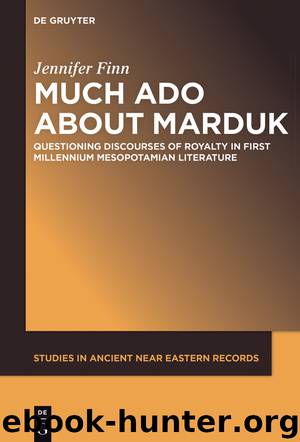Much Ado about Marduk by Jennifer Finn

Author:Jennifer Finn
Language: eng
Format: epub
Publisher: Walter de Gruyter
Published: 2017-05-25T16:00:00+00:00
Bīt rimki
Another ritual of the Neo-Assyrian period, which is perhaps more pertinent to our discussion, was called bīt rimki. Most studies of the series bīt rimki have been based on the ritual tablet BBR 26 (the joined fragments K 3227+3245 +6944+7813+8925+11149+10131), containing complete instructions for participants and a list of incantations to be recited during the performance of the ritual.409 Exemplars of the ritual tablet exist from Nineveh and late Babylonian Uruk. It is a matter of scholarly controversy whether or not the bīt rimki ritual is of Assyrian origin. Læssøe (1955: 89‒90) argues, based on circumstantial evidence, that the ritual was a custom specific to the Assyrians, and especially in the Sargonic period. Farber (1997: 41‒45), on the other hand, argues that the late example from Uruk (SpTU II 12) should be considered a copy of an early Babylonian original, on which the Nineveh copy depends (BBR 26, with which Læssøe’s study is primarily engaged). During the ritual, the king was led away to the open country by his ritual experts, where they would enter the bīt rimki (“house of ritual bath”), a structure of reeds in which temporary shrines were housed. The king was asked to recite a series of šu.íl.lá prayers to the major gods of the Mesopotamian pantheon, in which he sought their support and mercy. The next morning he would pass through seven ritual “houses,” performing purification rites and reciting prayers in each.410 At each house, before the rising sun (Šamaš, the divine judge), the king washed various parts of his body over several figurines, representing the threat or “enemy” to the kingship. In doing so, he not only rid himself of the threat to the kingship but also symbolically turned that threat against the enemy (Ambos 2013: 42). After completion of the purification associated with each house, the king was reinvested with his royal accoutrement. The removal of the threat allowed the king to return to his former, powerful status (Ambos 2013: 44). For this reason, Ambos (2013: 48) prefers to identify this ritual not as a “rite of passage” but rather as a “rite of return,” the same way as I have characterized the akītu ritual (above).
Constitutive of the bīt rimki ritual was its performance both before and after the completion of the substitute king ritual.411 The completion of the Ersatzkönigsritual (šar pūḫi, “the substitute king ritual”) was always necessitated by the presence of evil omens (most specifically, eclipses) that portended the death of the king (Parpola 1993: xxii). In this rite, there was a temporary replacement of the ruling king with a doppelgänger whose purpose was to absorb any potential dangers to the current ruler. The “dispensable person”412 would sit on the king’s throne and don the royal accoutrement. The evil omens were recited to the substitute king, while the reigning king was now called “the farmer” (lúengar).413 It is during this period as a “farmer” that the real king existed in a state of liminality, awaiting the change of state that would occur when he was allowed to come back to the throne.
Download
This site does not store any files on its server. We only index and link to content provided by other sites. Please contact the content providers to delete copyright contents if any and email us, we'll remove relevant links or contents immediately.
The Five People You Meet in Heaven by Mitch Albom(3334)
Real Sex by Lauren F. Winner(2861)
Name Book, The: Over 10,000 Names--Their Meanings, Origins, and Spiritual Significance by Astoria Dorothy(2836)
The Holy Spirit by Billy Graham(2775)
The Secret Power of Speaking God's Word by Joyce Meyer(2749)
ESV Study Bible by Crossway(2667)
How The Mind Works by Steven Pinker(2611)
0041152001443424520 .pdf by Unknown(2593)
Ancient Worlds by Michael Scott(2492)
The ESV Study Bible by Crossway Bibles(2410)
The Gnostic Gospels by Pagels Elaine(2393)
The Meaning of the Library by unknow(2385)
Churchill by Paul Johnson(2360)
MOSES THE EGYPTIAN by Jan Assmann(2275)
Jesus by Paul Johnson(2224)
City of Stairs by Robert Jackson Bennett(2222)
The Complete Dead Sea Scrolls in English (7th Edition) (Penguin Classics) by Geza Vermes(2135)
Ancient Near Eastern Thought and the Old Testament by John H. Walton(2129)
The Nativity by Geza Vermes(2111)
